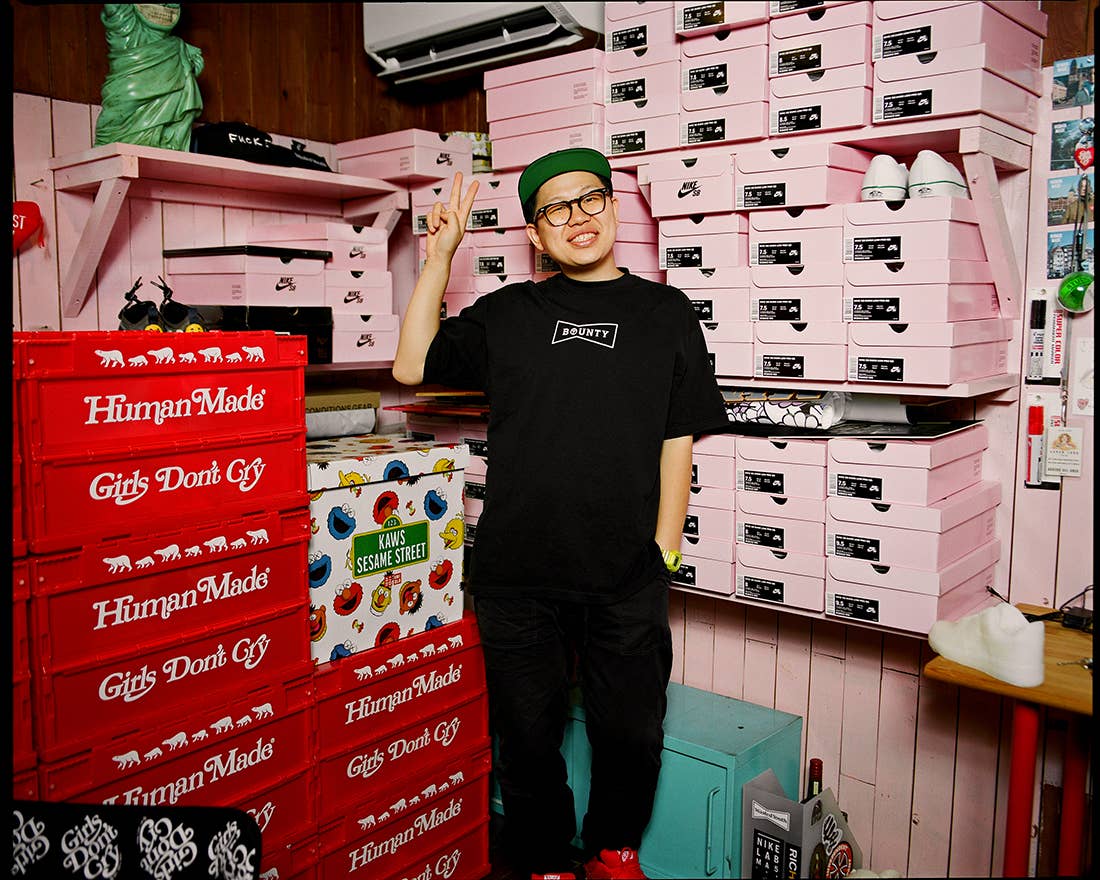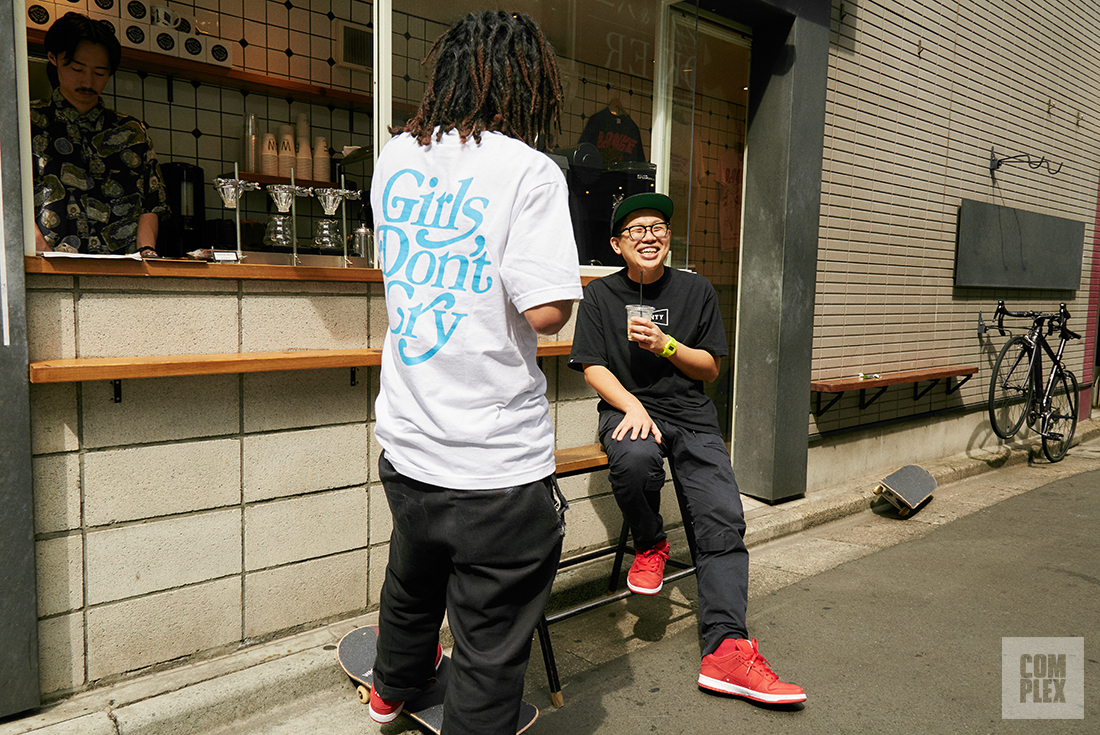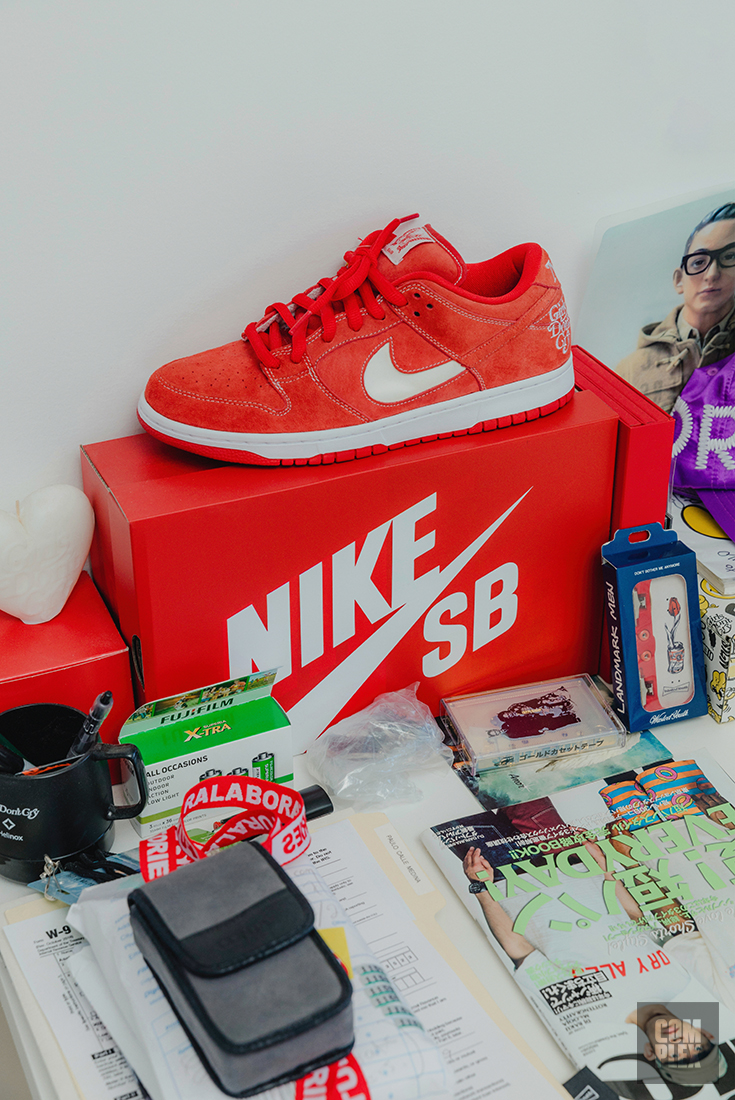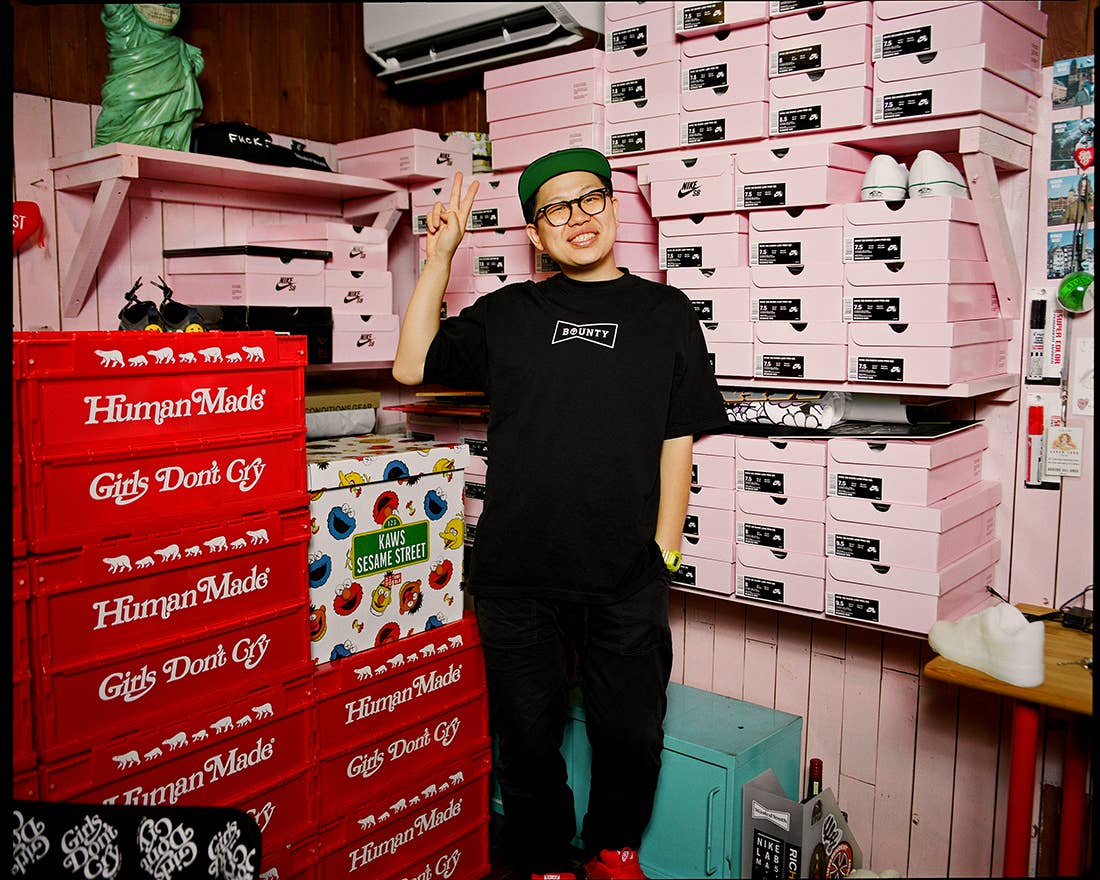
Verdy is always smiling—in photos and when you meet him. It’s the reason one of his graphics for VK Design, a new project, is a combination of the anarchy symbol and—yup, you guessed it—a yellow smiley face. “It’s a representation of me,” he says. “I like punk culture, but I’m always smiling.” Nothing seems to faze the 32-year-old artist/graphic designer, and even if it did, he’s not letting it get to him. There’s too much to focus on right now. Too much to be proud of.
Since launching Wasted Youth, a brand and skate team, in 2016 and Girls Don’t Cry a year later, Verdy has become a streetwear phenomenon. On any given day, his releases—T-shirts, keychains, hoodies, and more—draw hundreds, sometimes thousands, of people. He’s worked with everyone from Union Tokyo to Uniqlo and, earlier this year, dropped a highly coveted Girls Don’t Cry x Nike SB collaboration, which is now on the resale market for up to $5,000 (available only in Japan, the sneakers retailed for roughly $98). Even OGs like Undercover’s Jun Takahashi and NIGO®, both of whom have collaborated with Verdy, have given him their stamp of approval—high praise for any designer, new or old.
Verdy’s clearly got next. But just how far, and how big, does he want to go?
This past June, he invited us to his studio in Tokyo to talk about all things Girls Don’t Cry, Wasted Youth, and Verdy. Here, he discusses the origins of his brands, what it’s like to work with legends like NIGO® and Takahashi, how he really feels about the resale market, and more. Plus, he teases what’s on deck with Nike.
How did you get into graphic design?
I always liked to draw. In middle school, I got into Harajuku culture, and then, in high school, I got into skate culture. Graphic design is a part of both of those cultures, and that’s how I started designing for men’s. After I graduated from high school, I went to Osaka Design School. The first graphic design job I did was for the Light House [a music venue in Osaka]. I designed a calendar of the show schedule and some of their tickets. I did it for free for about a year.
Growing up, what brands do you remember wearing?
Dickies. I always liked to wear Bounty Hunter, but it was really expensive, so I went for skate brands like Spitfire and Thrasher. I liked Supreme, Antihero, and Undercover.

Bape was my entry to streetwear. I’m from Osaka, so it’s hard to get certain things there, but the first Bape item I purchased was a Pepsi collaboration of bottle caps. That’s how I started getting into [streetwear] more and more.
How do you think those brands inspire what you do now?
I’m probably more inspired by my friend's brands in L.A., like Rare Panther, Carrots, and Babylon. Just seeing how they don’t have a store but still have a strong brand through pop-ups and how they present their brand to people. I apply what they were doing in Japan.
You started designing album art for bands, but what led you to launch Wasted Youth about three years ago?
I realized I wasn’t able to show my own style or my own ideas as an artist. Wasted Youth reflects on some frustrations I had when I was younger. When I moved from Osaka to Tokyo, I spent the first six years struggling to make money and was living day by day. I could barely make rent. But after looking back at those six years, I thought nothing was wasted. I had to go through that to get to this. I designed a beer bottle with a flower blooming from inside, and that kind of expresses the fact that nothing is wasted. Wasted Youth also reflects on skate culture and punk culture, the two cultures that I really liked when I was younger. With Wasted Youth, I realized I didn’t want to make super-expensive clothes. I want to make accessible clothing.

Wasted Youth is a brand and a skate team. Why was it important for you to also start a skate team?
When I made the skate team, I felt like everything interesting was happening in Tokyo. I was frustrated about it and wanted to support my own community and my neighborhood. I wanted to contribute to my community rather than just having a pop-up store and selling my clothes. I wanted to do more to make the neighborhood more live.
What about Girls Don’t Cry? How did that idea come about?
Other than my love for skating and punk culture, something really important to my daily life is my wife. Girls Don't Cry is a message and kind of a present for my wife. We went to L.A. together for the first time [in 2017], and that's when I gifted my wife a T-shirt. At that time, I was in L.A. for a pop-up with [Carrots]. During the event, she wore the T-shirt for the first time and people started asking about it.
"It’s an honor. A co-sign is huge. Nigo® and Jun have held it down for so long, and there hasn’t really been a new lineage or a new generation of younger Japanese designers."
Can you tell me what inspires your graphics? You have different characters that regularly appear on your designs.
Those characters are inspired by old Disney characters. I have this character called Vick, which is a panda and a rabbit mixed together. Each character has a different message that comes from everyday feelings and emotions.
Last year, you released a Girls Don’t Cry x Nike SB collaboration, which sold out immediately. How did that partnership happen?
My friend from Los Angeles has connections with the Nike SB team. He connected us, but when the team came to Tokyo, they went into a pizza spot called Pizza Slice and saw a Girls Don’t Cry poster, and that got them more interested. I didn’t have money for billboards or advertising, so I asked my friend who works there to hang it in the store. From there, they asked me if I’d like to design a Dunk. Of course I said, “Hell yeah.” I started messaging with the Nike SB team, but I wanted to have a proper meeting in Portland. They flew me out there, and we started working on it.

Were you surprised by how successful the sneaker was? It sold out and was selling for $800, $900 on Grailed and StockX.
I understand how good the shoes are, so I wasn’t surprised by the success. I understand how much of an effort it was to get here, and the collaboration was just an accumulation of the success I was gaining. And the fact that it was a Japan-only release also increased demand.
I think this shoe put me on the map for a lot of people. But for me, I was just taking it one step at a time, building up projects. It was a logical extension of what I was doing.
Are you working with Nike on another collaboration?
Yes, we’re working on another project together.
How did you end up working with Jun Takahashi of Undercover?
I was out at a bar with Kunichi Nomura from Breakfast Club [a cafe in Tokyo] and he introduced me to Jun. I look up to him, so I was starstruck. I always carry [Girls Don’t Cry and Wasted Youth] pins and stickers with me, so Kunichi was like, “Verdy, give Jun one of your pins.” So I gave him one and he put it on on the spot. From there, we started working together.

What have you learned from working with him?
I send Jun older designs and he decides what makes sense for Undercover. He sets the tone and makes things look natural to Undercover. It’s hard to put into words what I’ve learned from him, but when I see something, I immediately know it’s from Jun and I want to figure out how to have that signature aesthetic.
Jun introduced you to NIGO®. What was that like?
Jun was talking to NIGO®—apparently they were talking about if they’d met anyone interesting or up-and-coming recently—and he asked NIGO® if he knew about me. He said I was interesting and that NIGO® and I would probably hit it off. So NIGO®’s team reached out. NIGO® is very low-key in Tokyo. He doesn’t go out at all, so I wasn’t even sure if he lived in Tokyo because I never saw him. The whole experience was just special. Being able to share ideas and stories and then collaborate on product was just special.
How does it feel to be co-signed by the older generation as the next one up?
It’s an honor. A co-sign is huge because I feel like NIGO® and Jun have held it down for so long, and there hasn’t really been a new lineage or a new generation of younger Japanese designers. It’s also good for people to see that the OGs are acknowledging younger people now. Younger people see that and they get inspired.

For some brands, having a high resale value signifies success. How do you feel about that?
I don’t think there’s anything wrong with it, but I don’t necessarily think it’s great, either. But it’s still nice to know that there are people out there who would put that price on my merch and want to buy it for that much. When I have pop-ups, there are guidelines to limit resellers and only let people buy one item, but I’ve realized that resellers are just a part of the game. When I was younger, I bought Supreme and Jordans from resellers. I appreciate that someone is willing to pay extra money for something I made, but I don’t have an opinion on resellers.
Do you feel high resale values have contributed to the success of your brands?
I do think that plays some role, but I’m not really focused on that. I just want to make good products, things to give to people I love. What happens to it after it’s released is beyond what I’m thinking about.
How big or mainstream do you want your brands to be?
I want to be mainstream, but that doesn't mean I want to expand all of a sudden. That doesn’t feel organic to me. I want to expand into different stores in different countries, but often I see cool brands from L.A. in Tokyo and they don't represent the brand the right way. I want to grow it to a size I can manage myself.
[Girls Don’t Cry] got big quite suddenly, and I became well known, so I get lots of offers now for collabs, and people want to stock my products in their stores. But I examine every offer closely to determine whether it’s something I actually want to do, whether having my products in a particular shop is the right fit for me. I don’t like to overdo it. I want to maintain the quality. I want the products to be cool and something I can stand behind. If you just oversell and everybody and their uncle is wearing it, it’s not a great outcome. I try to exercise caution in order to keep the integrity of the brand.

What’s been crucial to your success? It’s hard for a lot of brands to be big in Japan and the U.S., but Girls Don’t Cry is.
The logos, the designs, and messages on T-shirts were easy to understand from a Japanese point of view, and for people living in the States as well. I wanted to create something that would be cool in L.A. Japan is so small and it’s hard to make noise here, so I tried to make something that people in L.A. would like, and then people in Japan will see that and cover it.
You’re doing a Harajuku takeover later this year. What influenced you to do that?
I went to ComplexCon in Long Beach and Paris Fashion Week, and those were big inspirations. I wanted to do something similar in Japan, but I didn’t have the budget or space. But I figured I could negotiate with stores to make something like that happen in Harajuku, the neighborhood I’ve always been inspired by. It’s going to be over a Japanese holiday, which is a three-day weekend in October, with 20 or so shops releasing items at specific times. There will be collabs with Human Made, Levi’s, Awake, Babylon, [Takashi] Murakami, and more. I’m planning on making a five-meter version of the Vick character. And I want to make this a yearly thing, in October. I want to bring people together.
This story appears in our special, limited-edition "If You Build It, They Will Come" book, which features Kid Cudi and NIGO® on the cover. Buy a copy here.

